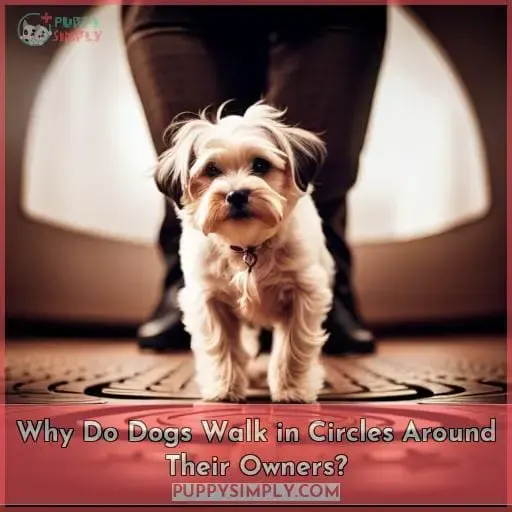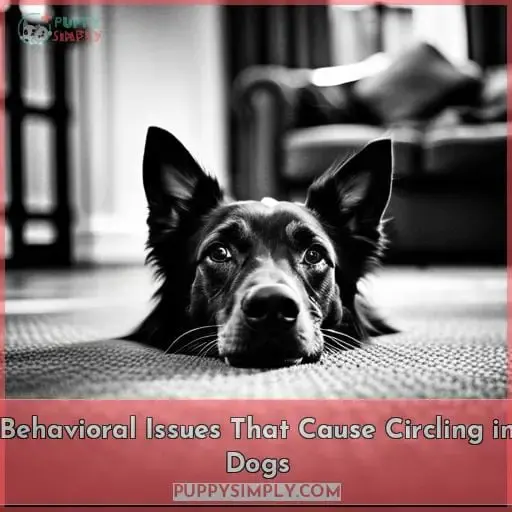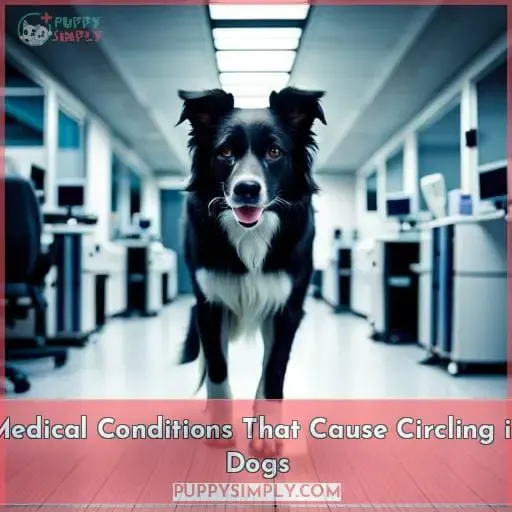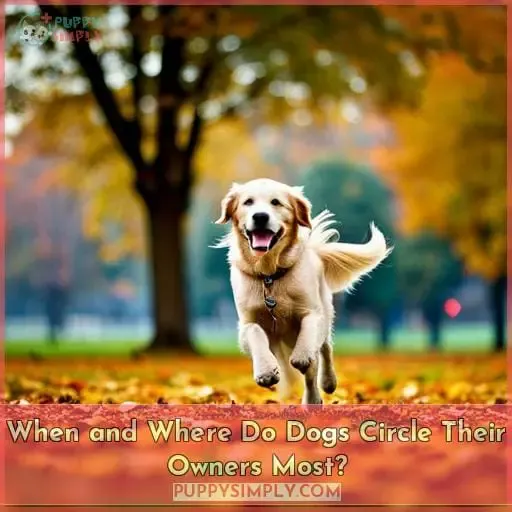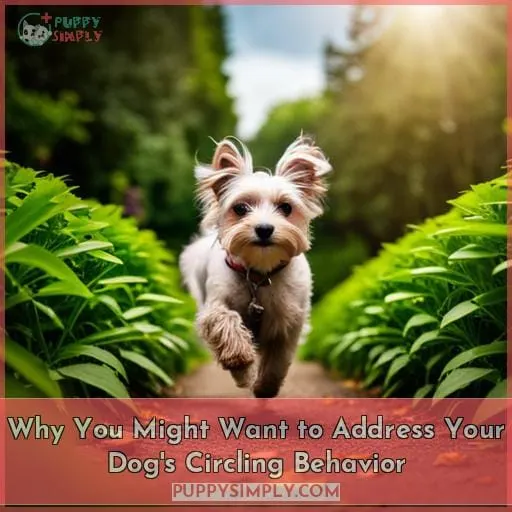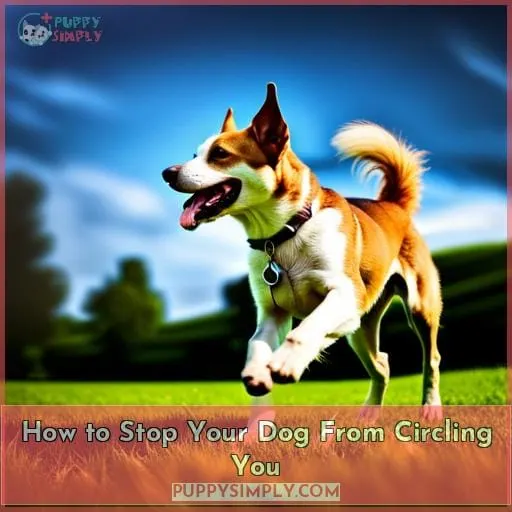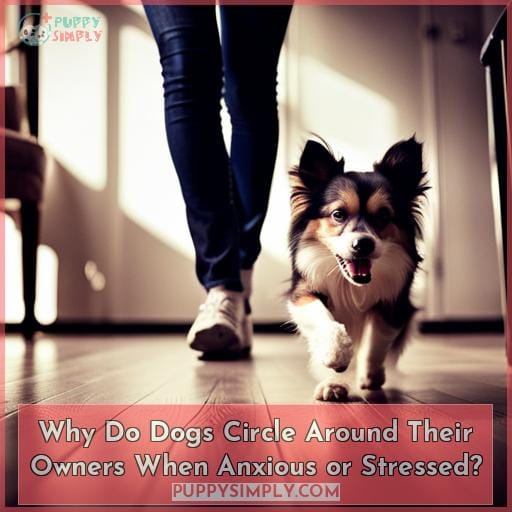This site is supported by our readers. We may earn a commission, at no cost to you, if you purchase through links.
 Have you ever wondered why your dog walks in circles around you? This behavior, although seemingly odd at first glance, is actually normal for dogs and can mean a variety of things. It’s important to understand the possible causes behind this action as it could indicate underlying medical or behavioral issues that need to be addressed.
Have you ever wondered why your dog walks in circles around you? This behavior, although seemingly odd at first glance, is actually normal for dogs and can mean a variety of things. It’s important to understand the possible causes behind this action as it could indicate underlying medical or behavioral issues that need to be addressed.
In this article, we will explore why dogs walk in circles around their owners. This behavior can be attributed to a range of factors, including excitement, dominance, pain, or stress. By understanding the reasons behind your pup’s habit, you can ensure they remain healthy and contented.
Circling behavior can be a sign of excitement. When dogs are happy and eager, they may circle around their owners as a way to release their energy. This is especially common when they anticipate something enjoyable, such as going for a walk or receiving a treat.
On the other hand, circling can also be a display of dominance. Dogs may walk in circles around their owners to assert their position and establish control. This behavior is more common in dogs with dominant personalities or those who have not been properly trained.
In some cases, circling can be a response to pain or discomfort. Dogs may walk in circles as a way to alleviate discomfort or to find a more comfortable position. If you notice your dog circling excessively or if they show signs of pain, it’s important to consult with a veterinarian to rule out any underlying medical conditions.
Lastly, circling can be a manifestation of stress or anxiety. Dogs may engage in this behavior when they feel overwhelmed or uncertain. It’s important to identify the triggers of your dog’s stress and work on reducing their anxiety through training, socialization, and providing a safe and calm environment.
If your dog’s circling behavior becomes problematic or excessive, it’s recommended to seek guidance from a professional dog trainer or behaviorist. They can help identify the underlying cause and provide you with strategies to address the issue effectively.
In conclusion, while it may seem peculiar, dogs walking in circles around their owners is a normal behavior with various possible causes. By understanding these causes and addressing any underlying issues, you can ensure your dog remains happy, healthy, and contented.
Table Of Contents
- Key Takeaways
- Why Do Dogs Walk in Circles Around Their Owners?
- What is Circling and Where Do Dogs Learn It?
- Why Do Dogs Circle Before They Lay Down?
- Behavioral Issues That Cause Circling in Dogs
- Medical Conditions That Cause Circling in Dogs
- When and Where Do Dogs Circle Their Owners Most?
- Why You Might Want to Address Your Dog’s Circling Behavior
- How to Stop Your Dog From Circling You
- Why Do Dogs Circle Around Their Owners When Excited?
- Why Do Dogs Circle Around Their Owners When Anxious or Stressed?
- Conclusion
Key Takeaways
- Excitement and anticipation can cause dogs to walk in circles around their owners.
- Circling behavior can be a sign of dominance or an ancestral instinct rooted in survival.
- Dogs may walk in circles due to pain, discomfort, stress, anxiety, or pent-up energy.
- It is important to consult a professional, avoid reinforcement, provide diversion, and respect the dog’s space to manage circling behavior effectively.
Why Do Dogs Walk in Circles Around Their Owners?
Do you wonder why your pup is walking in circles around you? This behavior could be due to a variety of reasons: excitement, dominance, hereditary behavior, pain or stress, and even ancestral instincts.
It’s important to understand the context of this circling behavior as it can give us insight into our dog’s well-being.
Excitement
Your pup might be joyfully spinning around you in excitement, showing off their playful nature and eagerness to join in whatever activity awaits. Excitement-induced circling is a normal behavior for dogs, but it can become problematic if it’s excessive or aggressive.
To reduce this type of circling, focus on rewarding positive behaviors and providing plenty of mental stimulation activities that will keep your dog busy. Managing excited circles during playtime can also help by redirecting attention away from the circling behavior to other activities like fetch or tugging games.
If anxiety or stress are causing the circling behavior, consider seeking professional training as these issues need special care and attention when addressing behavioral issues with your pup.
Dominance
When your pup circles you, it may be a sign they’re trying to assert dominance. Training and redirection can help manage this behavior.
Dominance in dogs is typically displayed through body language, such as standing tall or holding eye contact for prolonged periods of time. Signs of canine dominance include growling or barking, resource guarding food bowls and toys, moving into the owner’s space without permission, and excessive jumping on people and furniture.
Proper training techniques, like positive reinforcement, can effectively address signs of canine dominance while also boosting their confidence levels. Additionally, if medical issues like vestibular syndrome or anxiety are present, appropriate treatment should be sought from a veterinarian to ensure the overall health and well-being of your pet companion.
Hereditary Behavior
Certain breeds of dogs may have a hereditary tendency to circle around you, stemming from their wild ancestors’ survival instincts. Genetic traits are passed on through generations and can influence circling habits in dogs.
Inherited instincts like herding may be why some breeds circle more than others before settling down for sleep or rest. Breeds such as Border Collies and Australian Shepherds tend to have strong herding tendencies that can be managed by providing mental stimulation or physical exercise activities like stock dog trials.
Other genetic circling tendencies could also include Bull Terriers chasing their tails compulsively, so keep an eye out for any abnormal behavior patterns your pup might display due to inherited traits!
Pain or Stress
If your pup is circling you, it could be a sign of pain or stress, so take note if they’re spinning their wheels. Medical conditions like infections and parasites may cause them to circle excessively and should be assessed by a veterinarian for proper treatment.
Behavioral issues such as anxiety or boredom can also lead to dogs walking in circles seeking attention from their owners. Stress management tools like behavioral training can help reduce anxious behavior while providing positive reinforcement when necessary.
Additionally, certain medical conditions such as arthritis or liver disease require immediate health assessment that might explain why the dog is exhibiting this type of behavior.
Ancestral Instincts
Your pup’s circling behavior may be a result of their ancestral instincts. Many canine behaviors, such as scent detection and temperature regulation, stem from ancient survival strategies. Wild dogs circle to locate the best sleeping spot based on scent, comfort, and temperature preferences.
Instinctual circling is also influenced by breed-specific traits like herding in Border Collies or compulsive tail chasing in Bull Terriers.
What is Circling and Where Do Dogs Learn It?
You may have noticed that your pup sometimes engages in circling behavior, but what is it and where did they learn it? Circling origins can be traced back to their ancestral behaviors; many dogs still retain certain survival instincts from their wild ancestors.
It’s commonly used as a means of scent detection, comfort regulation, or temperature control when lying down.
The learning process involves environmental influences like behavioral issues such as anxiety or boredom, which can result in circular movements around the owner. Herding instincts are often observed in breeds like Border Collies and Australian Shepherds due to their natural herding tendencies.
This prompts them to circle people while seeking attention and direction from an authoritative figure.
Behavioral influences also play an important role, with some dogs becoming anxious if separated for too long from their humans. This can lead to compulsive circling behavior known as separation anxiety disorder (SAD).
With proper training methods involving positive reinforcement techniques combined with adequate exercise levels, owners can decrease the prevalence of this undesirable trait among pups prone to these habits.
They can redirect them away from areas where they tend to display such behaviors most frequently.
Why Do Dogs Circle Before They Lay Down?
Have you ever noticed your dog circling around you before they lay down? This behavior is rooted in a canine’s natural instincts to scent, seek comfort, and regulate temperature. Dogs will often meticulously circle the area where they are about to rest for reasons that go beyond simply getting comfortable.
Scent
Sniffing the air and searching for a comfortable spot, your pup is guided by instinct as they circle before settling in. Circling helps dogs detect scents from other animals, locate food sources, mark their territory, and communicate with other canines.
This behavior can also help them regulate temperature or seek attention from their owners.
To prevent circling from becoming excessive or aggressive due to medical issues such as infections or parasites, it’s important to keep up regular preventive measures like flea treatments and vet visits.
Professional dog training may also be beneficial if needed to reinforce desired behaviors when your pup circles around you.
Comfort
Wrapping yourself in a cozy blanket, you understand why your dog circles before settling down – comfort is key. Circling can be an anxious dog’s way of seeking relief from pain or discomfort and staying close to its owner.
It may also help them detect scent as they look for the perfect spot to lie down.
To prevent any potential infections or diseases that come with circling, preventive measures such as regular health check-ups and reducing stress are necessary for dogs’ wellbeing. Offering comfortable beds with cushioned support can also reduce unnecessary walking and provide warmth during colder climates.
Knowing how important comfort is for our furry friends helps us better understand their behaviors when it comes to choosing sleeping spots – so let’s make sure we create the best environment possible!
Temperature
By circling around you, your pup may be trying to regulate their temperature before they settle down. Temperature preferences are likely hereditary factors for certain breeds, while medical causes and behavioral circling can also play a role.
If this behavior becomes excessive or aggressive, consult with a veterinarian to rule out any health issues like anal glands or vestibular disease in dogs. Training is often the best way to stop dog circling from becoming problematic, and redirecting herding instincts through activities such as stock dog trials can help too.
Dogs’ wild ancestors often circled for scent detection, so it’s important we understand our furry friends’ needs!
Behavioral Issues That Cause Circling in Dogs
It is important to understand the behavioral issues that can cause a dog to walk in circles around its owner, such as temperament, pent-up energy, encouragement, and emotional trauma. Dogs often circle when they have too much energy or are feeling anxious; this behavior may also be encouraged if an owner gives attention when their pet circles them.
Additionally, dogs may circle due to underlying emotional traumas from past experiences. Understanding these potential causes of circling behavior can help ensure that your pup remains happy and healthy.
Temperament
Your pup’s temperament can influence why they circle around you. Monitor changes that might point to underlying issues; after all, it’s better to be safe than sorry. Dog temperament and socialization benefits are important for canine behavior training techniques.
Temperament assessments help identify potential problems such as fear reactions or aggression in dogs, while also providing insight into possible bodily injuries like arthritis or hip dysplasia.
Pent-up Energy
Excessive circling can be a sign of pent-up energy, so it’s important to provide your pup with plenty of mental stimulation and physical exercise.
First, take long walks or hikes in the park. This not only provides exercise but also allows your dog to explore and experience new sights and smells.
Second, play interactive games such as fetch and tug-of-war. These games engage your dog’s mind and body, providing both physical and mental stimulation.
Third, provide puzzles for dogs to solve. These can be toys that require your dog to figure out how to get a treat or a toy out of them.
It’s important to remember that playful puppies need outlets to express themselves naturally, while hyperactive dogs may require extra attention from their owners.
Exercise solutions like jogging or swimming can also help tire out these furry friends. These activities provide a higher level of physical exertion and can be a great way to burn off excess energy.
By engaging in these activities and providing enough mental and physical stimulation, pet parents can have healthier relationships with their canine companions, free from anxiety caused by excessive circling behavior.
Encouragement
You can encourage more appropriate circling behavior by providing your pup with positive reinforcement when they circle in the right direction. Training methods such as encouragement techniques, motivational cues, and behavioral rewards are all effective in helping to shape desired behavior.
Positive reinforcement is key for these activities. Rewarding your dog with treats or compliments helps them associate this action with good feelings and promotes repetition of the desired actions.
Additionally, you can provide verbal commands along with physical ones. For example, you can point at where you want them to go and offer a toy or treat if they stay focused on that spot instead of wandering off again.
Emotional Trauma
Unresolved emotional trauma can lead to excessive circling in your pup, as they may be seeking comfort or distraction from their distress. The recovery process is often a long and difficult journey that will require patience and understanding on the part of the dog’s owner.
Coping strategies like providing mental stimulation, physical exercise, and positive reinforcement training techniques, as well as adequate rest time throughout the day, are key for helping them heal physically and emotionally.
Behavioral changes, such as increased pacing or spinning, should also be monitored closely in order to identify any potential triggers that could cause further upset or anxiety.
With proper emotional support and guidance, along with consistency during this healing journey, many dogs can learn how to manage their behaviors more effectively over time and eventually overcome whatever trauma they experienced previously.
Medical Conditions That Cause Circling in Dogs
Circling behavior in dogs can have multiple causes, including medical conditions such as dementia, ear infections, vestibular syndrome, concussion, and parasites. These illnesses can cause a variety of symptoms that lead to circling or disorientation.
Understanding how these ailments affect your dog’s behavior is an important part of their care.
Dementia
Have you ever noticed your pup acting strangely, circling around with no apparent purpose? Dementia is one possible medical condition that can cause this type of behavior in dogs. Symptoms include disorientation, confusion, and changes in personality or activity level.
If dementia is suspected as the source of abnormal circling behavior, owners should seek veterinary advice for diagnosis and care tips to help manage their pet’s symptoms. With proper treatment plans tailored to individual needs based on medical history information gathered by the vet during an assessment visit, owners will have a better chance at helping their dog live a full life while managing any behavioral issues related to dementia in dogs properly.
Ear Infection
Ear infections can cause your pup to circle you, as their ears become itchy and uncomfortable. Regular ear cleanings should be performed to prevent ear infections. Veterinary care should be sought if symptoms such as head shaking or frequent pawing at the ears are present.
Cleaning the outer ear with a cotton swab is also advised for general preventive measures against infection development in pups with hairy inner ears. These inner ears can trap dirt or waxy buildup over time. Owners must keep an eye out for other signs of infection like redness and discharge during routine health checks to ensure early detection and prompt treatment if necessary.
With proper hygiene practices in place, along with veterinary care when needed, your pup’s overall ear health will remain strong year-round!
Vestibular Syndrome
Vestibular Syndrome can be a scary and disorienting condition for your pup, causing them to circle uncontrollably.
Symptoms of vestibular syndrome include balance issues, vertigo-like symptoms, and head tilting. Treatment options include medication to reduce inflammation in the inner ear as well as physical therapy exercises.
Canine vertigo is an inner ear disorder that may cause circling behaviors due to loss of balance control or dizziness. If you notice any changes in your pup’s behavior that indicate they are having difficulty with their equilibrium, it’s important not to ignore these signs and consult with a veterinarian right away for diagnosis and treatment options.
Concussion
You may not realize it, but a concussion can be the cause of your pup’s sudden circling behavior. Head trauma from falls and car accidents can lead to neurological damage that causes vestibular syndrome-like symptoms in dogs.
These symptoms include imbalance, head tilt, nystagmus (rapid eye movements), circles, or pacing due to disorientation.
Treatment usually involves medications such as antihistamines or steroids to reduce inflammation.
Prevention is key. Make sure your pet wears an appropriate harness when riding in vehicles to protect against sudden stops or accidents. Additionally, it is important to monitor your pet during playtime outdoors, especially around stairs or high places where they could fall and potentially suffer head injuries.
Parasites
Parasites can also be a potential cause of circling behavior in dogs, so it’s important to check with your vet if you notice any changes. Parasitic infections are caused by many different types of parasites and can have serious health implications for your pet.
Prevention is key when it comes to keeping your dog healthy and free from parasitic infections. Regular deworming treatments, along with proper grooming habits, should help reduce the chances of infection.
When and Where Do Dogs Circle Their Owners Most?
Your pup may be spinning their wheels when it comes to circling you, as most dogs tend to do this primarily when they’re feeling excited or looking for attention.
- Seeking Attention: Dogs often circle around humans in order to get attention from them.
- Herding Breeds: Certain breeds such as Border Collies and Australian Shepherds are more likely to circle due to their herding instincts.
- Circling Patterns: Some dogs will have a specific pattern of circling that is unique to them, while others circle randomly indoors or outdoors.
- Indoor vs Outdoor Activity Levels: Depending on the dog’s activity level, some may prefer indoor circles while others prefer outdoor ones during the evening rituals.
Circling behavior can also indicate a medical condition, so if your pet has been exhibiting this type of behavior for an extended period of time, consulting with your veterinarian might be necessary. Additionally, certain training techniques like redirection commands can help redirect excessive circling behaviors, such as sit instead.
Why You Might Want to Address Your Dog’s Circling Behavior
It’s important to be aware of the potential reasons behind your pup’s circling behavior and address any issues that may arise. Behavioral training and redirection techniques can help deter unwanted circling, as well as address medical concerns or hereditary traits.
For instance, herding breeds like Border Collies or Australian Shepherds may circle due to their natural instincts, while Bull Terriers might spin in circles out of boredom or anxiety. Additionally, a vet should be consulted if there are changes in circling behavior that could indicate underlying health conditions such as vestibular disease, organ failure, or dementia.
By identifying the cause for your dog’s movements, you can better manage it with appropriate solutions. These may include providing mental stimulation for bored dogs through interactive games and activities, redirecting attention-seeking behaviors by rewarding calmness instead, avoiding rewards when they start spinning around, using positive reinforcement during leash walks, and speaking calmly when addressing fear-based responses from anxious pups.
How to Stop Your Dog From Circling You
If your pup is displaying circling behavior, it is important to understand the underlying cause and take appropriate measures to address it. Consulting a veterinarian can help you rule out any medical issues that may be present.
Additionally, it is important to avoid reinforcing this behavior as much as possible. Instead, provide diversion by giving them something else to focus on or give them space if they need some time away from you.
Consult a Vet
If you’re unsure about the cause of your pup’s circling, it’s best to consult a vet. A professional can provide an accurate medical evaluation and behavioral assessment to determine any underlying health concerns or causes for the circling behavior.
By considering both physical and mental aspects of your pet, they can better identify potential issues that may be causing this behavior. During the vet consultation, discuss all possible factors contributing to aggressive or excessive circling as well as any changes in overall activity level or responsiveness from your dog.
With proper veterinary care and guidance, you’ll have a better understanding of how to address this issue with training strategies if necessary.
Avoid Reinforcement
To prevent reinforcing circling behavior, avoid giving your pup attention when they circle around you. Instead, use training techniques such as redirection and behavior modification to correct the unwanted action.
For example, redirect their focus with commands like sit or down. Reward good behaviors with treats and praise. Provide mental stimulation through games or toys that require problem-solving skills. Use behavioral correction methods such as a leash tug followed by verbal disapproval.
Finally, practice reinforcement avoidance by not rewarding inappropriate actions with food or affection.
By implementing these strategies consistently over time, owners can help break the cycle of undesired circling behavior in dogs.
Provide Diversion
Provide your pup with some distraction when you notice them circling, such as a quick game of fetch or tug-of-war. Engagement techniques, like interactive toys and outdoor activities, can help keep them occupied and mentally stimulated.
Distraction methods, like hiding treats in puzzles or playing hide-and-seek, are also good ways to break the pattern of their behavior.
Give Them Space
Give your pup the space they need when they start to circle, as this can help reduce their anxiety or excitement and allow them to relax. Respect their boundaries and provide independence by avoiding crowding them while also encouraging exploration in more suitable areas.
This will create an environment that fosters trust between you both, helping your dog feel safe around you instead of anxious or overwhelmed.
Why Do Dogs Circle Around Their Owners When Excited?
Surrounded by the familiar sights and smells of home, your pup’s excitement may express itself in a unique way: circling around you – an adage for ‘a change is as good as a rest’! This behavior could be harmless or hint at something more serious.
Commonly, dogs circle due to anticipation of activities or seeking attention. Circling can also be dominance indicators in some breeds while herding instinct-driven circles often appear with border collies and Australian shepherds.
Medical conditions like infections, parasites, vestibular disease, and arthritis should not go unnoticed if excessive scooting occurs alongside this behavior too.
Paying close attention to any changes in their circling behaviors is key when managing your dog’s overall health; consult vets for further clarity if necessary.
Why Do Dogs Circle Around Their Owners When Anxious or Stressed?
When feeling anxious or stressed, your pup may start to circle you as a way of seeking comfort and security. Circling can be caused by several factors, including herding instincts, behavioral responses to stressful situations, and underlying health concerns.
Herding instinct is often seen in dogs that belong to breeds such as border collies or Australian shepherds, who have the natural urge to herd livestock. This behavior can become problematic if done excessively in an urban environment where there are no animals around for them to herd due to their strong instinctive drive.
Behavioral responses, such as anxiety-induced circling, may be present when facing unknown environments surrounded by unfamiliar people or objects. This behavior leads them back towards their owners for safety purposes while managing stress levels throughout the situation at hand.
Lastly, medical issues like infections, parasites, and vestibular disease could potentially lead pups into circling behaviors. It is important that any changes in this type of behavior should not go unnoticed but rather addressed immediately upon observation from a veterinary professional before further complications arise regarding your dog’s overall health condition.
Conclusion
When it comes to understanding why dogs walk in circles around their owners, it’s important to consider the various causes and solutions.
Take Lisa and her Border Collie, for example. Lisa was concerned when she noticed her dog circling her whenever she came home from work. After some research, Lisa discovered that her dog’s circling behavior was a sign of excitement and anticipation of activities.
To address this, Lisa gave her dog more exercise and mental stimulation and redirected her behavior with commands like sit.
Circling can also be a sign of dominance, hereditary behavior, pain or stress, or ancestral instincts. In some cases, medical conditions like infections, parasites, and vestibular disease can be the cause.
To prevent circling behavior, owners should avoid reinforcing it and provide their dogs with plenty of exercise and mental stimulation. Knowing why dogs circle can help owners better manage their behavior and build a healthy relationship with their pup.

